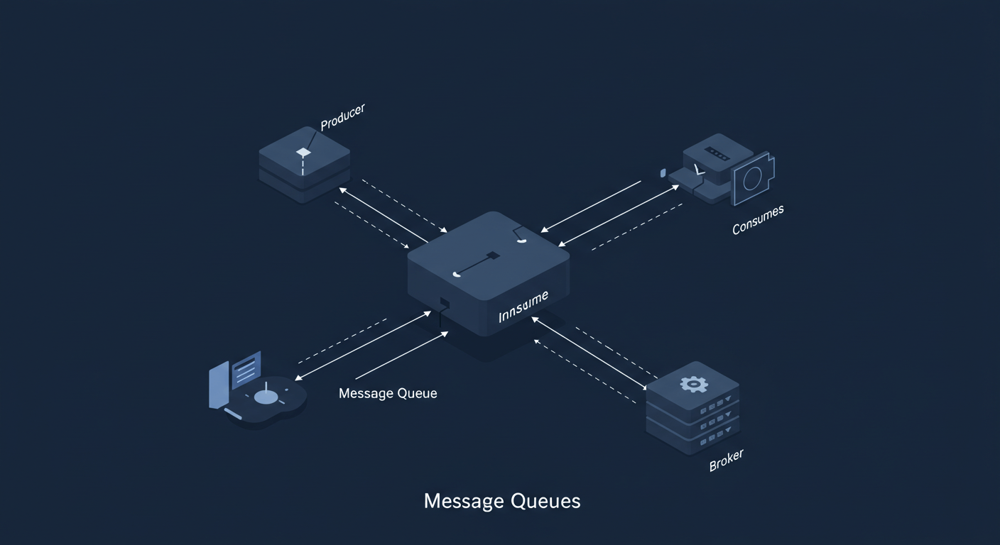In modern system design, message queues play a pivotal role in enabling communication between different parts of distributed systems. As companies scale their applications and increase complexity, the need for asynchronous, decoupled communication patterns becomes essential. Message queues provide a robust solution to this challenge by acting as intermediaries that ensure reliable and efficient message delivery between services.
This article explores the fundamental concepts of message queues, their types, how they work, their advantages, and real-world examples. By the end, you'll have a solid understanding of why message queues are a cornerstone of modern system architectures.
Basic Architecture of Message Queues
At their core, message queues facilitate communication between a producer (the sender of a message) and a consumer (the receiver of a message). The message queue itself is a storage medium that temporarily holds messages until the consumer is ready to process them.
Here’s a high-level overview of the architecture:
- Producer: An application or service that generates messages. For example, an e-commerce application might send a message when a user places an order.
- Queue: A buffer that stores messages. It ensures that messages are reliably held until they are consumed.
- Consumer: An application or service that processes messages from the queue. For instance, the consumer might process the order message to update inventory or notify the warehouse.
Example Diagram Structure:
Producer 1 ----> Message Queue <---- Consumer 1
Producer 2 ----> ----> Consumer 2Key Characteristics of Message Queues:
- Asynchronous Communication: Producers and consumers do not need to interact in real-time. A producer can send messages even if the consumer is offline.
- Decoupling: Message queues allow systems to remain loosely coupled. Producers don’t need to know how or where messages will be processed.
Types of Message Queues
Message queues come in several varieties, each designed to address specific use cases. Below are the most common types:
Point-to-Point Queues
Task distribution systems, where each task should be processed by only one worker.
- Once the message is consumed, it is removed from the queue.
- In this model, a message is delivered to a single consumer.
Example Diagram Structure:
Producer ----> Point-to-Point Queue ----> ConsumerPublish-Subscribe Queues
In the publish-subscribe model, producers send messages that are broadcast to multiple subscribers. Consumers can subscribe to specific topics or channels to receive messages relevant to them. For use case, notification systems where multiple services (e.g., email, SMS) need to be notified of the same event.
Example Diagram Structure:
Publisher ----> Message Broker
/ \
/ \
Subscriber 1 Subscriber 2Priority Queues
Messages are assigned priorities, and higher-priority messages are processed before lower-priority ones. For use case, emergency alert systems where critical updates need immediate attention.
Example Diagram Structure:
Producer 1 (High Priority) ---->
|
Producer 2 (Low Priority) -----> Priority Queue ----> ConsumerFIFO Queues
FIFO (First In, First Out) queues ensure that messages are processed in the exact order they are received. For use case, financial transaction systems where the order of operations is crucial.
Example Diagram Structure:
Producer ----> FIFO Queue ----> ConsumerDead Letter Queues
Dead letter queues store messages that cannot be processed (e.g., due to errors or retries exceeding a limit). For use case, debugging and error handling in distributed systems.
Example Diagram Structure:
Producer 1 ----> Main Queue ----> Consumer
\
----> Dead Letter QueueHow Message Queues Work
Let’s dive deeper into the mechanics of message queues. While implementations vary across platforms, the general workflow is as follows:
- Message Production: Producers create messages, often in a predefined format (e.g., JSON, XML). Each message includes metadata, such as timestamps or identifiers, to aid in processing.
- Message Storage: Messages are placed into the queue, where they are stored temporarily. Depending on the queue type, messages may be persisted to disk for durability or held in memory for speed.
- Message Consumption: Consumers retrieve messages from the queue. This process can occur in pull mode (the consumer requests messages) or push mode (the queue delivers messages to the consumer).
- Acknowledgment and Deletion: After processing a message, the consumer sends an acknowledgment to the queue. The queue then deletes the message to prevent reprocessing.
Advantages of Using Message Queues
Message queues are integral to modern system design due to their numerous benefits:
- Asynchronous Processing:
- Producers and consumers can operate independently, avoiding the need for real-time communication.
- This is particularly useful in high-traffic systems where immediate processing is not feasible.
- Scalability:
- By decoupling services, message queues enable horizontal scaling. Multiple consumers can process messages simultaneously to handle increased load.
- Fault Tolerance and Reliability:
- Message queues ensure that messages are not lost, even if consumers or producers fail temporarily. Persistent storage provides durability.
- Load Balancing:
- In a multi-consumer setup, message queues can distribute tasks evenly, preventing bottlenecks.
- Improved System Resilience:
- Decoupled systems are less prone to cascading failures. If one service goes down, others can continue functioning.
- Flexibility:
- By using different types of queues (e.g., priority or FIFO), developers can tailor the system to meet specific requirements.
Examples of Message Queues
Several popular message queue platforms are widely used in the industry:
- RabbitMQ:
- A feature-rich, open-source message broker.
- Strengths: Robust support for multiple protocols (AMQP, MQTT), flexible routing mechanisms.
- Use Case: E-commerce order processing systems.
- Apache Kafka:
- A distributed event-streaming platform that acts as a high-throughput message queue.
- Strengths: High scalability, fault tolerance, and replay capabilities.
- Use Case: Real-time analytics pipelines.
- Amazon SQS (Simple Queue Service):
- A fully managed message queuing service provided by AWS.
- Strengths: Seamless integration with AWS ecosystem, serverless architecture.
- Use Case: Background job processing for cloud applications.
- Redis:
- While primarily an in-memory data store, Redis can also function as a lightweight message queue.
- Strengths: High-speed performance.
- Use Case: Real-time chat applications.
Summary
Message queues are indispensable in designing scalable, reliable, and efficient systems. By enabling asynchronous communication and decoupling components, they allow developers to build systems that are flexible, fault-tolerant, and resilient to failure. Whether you’re implementing task distribution, event-driven architectures, or real-time analytics, message queues like RabbitMQ, Kafka, and Amazon SQS provide the tools needed to handle complex workflows.
Understanding the nuances of message queues—such as their types, mechanisms, and use cases—empowers developers to make informed decisions when architecting systems. As the demand for distributed systems continues to grow, mastering message queues will remain a vital skill for any developer or system architect.
Last Update: 03 Feb, 2025

